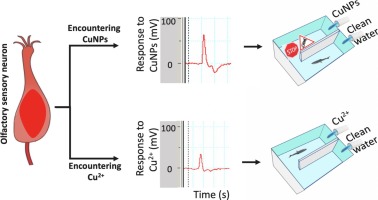当前位置:
X-MOL 学术
›
Environ. Pollut.
›
论文详情
Our official English website, www.x-mol.net, welcomes your feedback! (Note: you will need to create a separate account there.)
Rainbow trout (Oncorhynchus mykiss) chemosensory detection of and reactions to copper nanoparticles and copper ions.
Environmental Pollution ( IF 8.9 ) Pub Date : 2020-01-07 , DOI: 10.1016/j.envpol.2020.113925 Parastoo Razmara 1 , Justin Sharpe 1 , Gregory G Pyle 1
Environmental Pollution ( IF 8.9 ) Pub Date : 2020-01-07 , DOI: 10.1016/j.envpol.2020.113925 Parastoo Razmara 1 , Justin Sharpe 1 , Gregory G Pyle 1
Affiliation

|
Copper is known to interfere with fish olfaction. Although the chemosensory detection and olfactory toxicity of copper ions (Cu2+) has been heavily studied in fish, the olfactory-driven detection of copper nanoparticles (CuNPs)-a rapidly emerging contaminant to aquatic systems-remains largely unknown. This study aimed to investigate the olfactory response of rainbow trout to equitoxic concentrations of CuNPs or Cu2+ using electro-olfactography (EOG, a neurophysiological technique) and olfactory-mediated behavioural assay. In the first experiment, the concentration of contaminants known to impair olfaction by 20% over 24 h (EOG-based 24-h IC20s of 220 and 3.5 μg/L for CuNPs and Cu2+, respectively) were tested as olfactory stimuli using both neurophysiological and behavioural assays. In the second experiment, to determine whether the presence of CuNPs or Cu2+ can affect the ability of fish to perceive a social cue (taurocholic acid (TCA)), fish were acutely exposed to one form of Cu-contaminants (approximately 15 min). Following exposure, olfactory sensitivity was measured by EOG and olfactory-mediated behaviour within a choice maze was recorded in the presence of TCA. Results of neurophysiological and behavioural experiments demonstrate that rainbow trout can detect and avoid the IC20 of CuNPs. The IC20 of Cu2+ was below the olfactory detection threshold of rainbow trout, as such, fish did not avoid Cu2+. The high sensitivity of behavioural endpoints revealed a lack of aversion response to TCA in CuNP-exposed fish, despite this change not being present utilizing EOG. The reduced response to TCA during the brief exposure to CuNPs may be a result of either olfactory fatigue or blockage of olfactory sensory neurons (OSNs) by CuNPs. The observed behavioural interference caused by CuNP exposure may indicate that CuNPs have the ability to interfere with other behaviours potentially affecting fitness and survival. Our findings also revealed the differential response of OSNs to CuNPs and Cu2+.
中文翻译:

虹鳟(Oncorhynchus mykiss)对铜纳米颗粒和铜离子的化学感应检测和反应。
众所周知,铜会干扰鱼类的嗅觉。尽管已经在鱼类中对铜离子(Cu2 +)的化学感官检测和嗅觉毒性进行了深入研究,但嗅觉驱动的铜纳米颗粒(CuNPs)(一种快速出现的对水生系统的污染物)的检测仍非常未知。这项研究旨在调查虹鳟鱼对嗅觉响应的等毒性浓度的CuNPs或Cu2 +,使用电子嗅觉描记术(EOG,一种神经生理学技术)和嗅觉介导的行为分析。在第一个实验中,使用神经生理学和生理学方法测试了已知会在24小时内嗅觉降低20%的污染物浓度(基于EOG的24-h IC20,CuNPs和Cu2 +的IC20分别为220和3.5μg/ L)作为嗅觉刺激。行为分析。在第二个实验中 为了确定CuNPs或Cu2 +的存在是否会影响鱼类感知社交线索的能力(牛磺胆酸(TCA)),将鱼类急性暴露于一种形式的Cu污染物(约15分钟)。暴露后,通过EOG测量嗅觉敏感性,并在存在TCA的情况下记录选择迷宫中的嗅觉介导行为。神经生理和行为实验的结果表明,虹鳟鱼可以检测和避免CuNPs的IC20。Cu2 +的IC20低于虹鳟鱼的嗅觉检测阈值,因此,鱼类无法避免Cu2 +。行为终点的高敏感性表明,在暴露于CuNP的鱼类中,对TCA缺乏厌恶反应,尽管利用EOG尚无此改变。短暂暴露于CuNPs期间对TCA的反应减少可能是嗅觉疲劳或CuNPs阻塞嗅觉感觉神经元(OSNs)的结果。观察到的由CuNP暴露引起的行为干扰可能表明CuNP具有干扰可能影响健康和生存的其他行为的能力。我们的发现还揭示了OSN对CuNP和Cu2 +的不同反应。
更新日期:2020-01-07
中文翻译:

虹鳟(Oncorhynchus mykiss)对铜纳米颗粒和铜离子的化学感应检测和反应。
众所周知,铜会干扰鱼类的嗅觉。尽管已经在鱼类中对铜离子(Cu2 +)的化学感官检测和嗅觉毒性进行了深入研究,但嗅觉驱动的铜纳米颗粒(CuNPs)(一种快速出现的对水生系统的污染物)的检测仍非常未知。这项研究旨在调查虹鳟鱼对嗅觉响应的等毒性浓度的CuNPs或Cu2 +,使用电子嗅觉描记术(EOG,一种神经生理学技术)和嗅觉介导的行为分析。在第一个实验中,使用神经生理学和生理学方法测试了已知会在24小时内嗅觉降低20%的污染物浓度(基于EOG的24-h IC20,CuNPs和Cu2 +的IC20分别为220和3.5μg/ L)作为嗅觉刺激。行为分析。在第二个实验中 为了确定CuNPs或Cu2 +的存在是否会影响鱼类感知社交线索的能力(牛磺胆酸(TCA)),将鱼类急性暴露于一种形式的Cu污染物(约15分钟)。暴露后,通过EOG测量嗅觉敏感性,并在存在TCA的情况下记录选择迷宫中的嗅觉介导行为。神经生理和行为实验的结果表明,虹鳟鱼可以检测和避免CuNPs的IC20。Cu2 +的IC20低于虹鳟鱼的嗅觉检测阈值,因此,鱼类无法避免Cu2 +。行为终点的高敏感性表明,在暴露于CuNP的鱼类中,对TCA缺乏厌恶反应,尽管利用EOG尚无此改变。短暂暴露于CuNPs期间对TCA的反应减少可能是嗅觉疲劳或CuNPs阻塞嗅觉感觉神经元(OSNs)的结果。观察到的由CuNP暴露引起的行为干扰可能表明CuNP具有干扰可能影响健康和生存的其他行为的能力。我们的发现还揭示了OSN对CuNP和Cu2 +的不同反应。


























 京公网安备 11010802027423号
京公网安备 11010802027423号